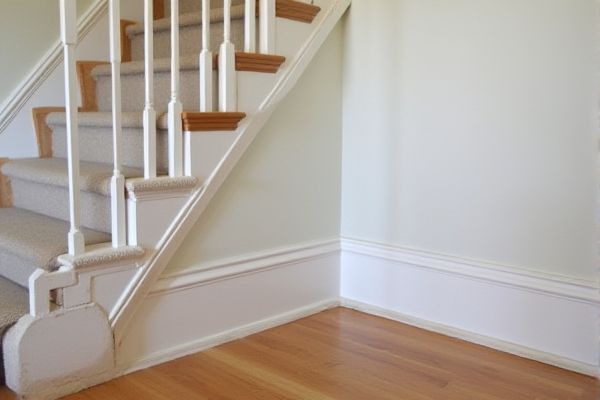
Lattice skirting offers a decorative, breathable design that enhances ventilation and prevents moisture buildup, while solid skirting provides a sturdy, more secure barrier against pests and debris. Discover which option best suits your needs by exploring the full article.
Table of Comparison
| Feature | Lattice Skirting | Solid Skirting |
|---|---|---|
| Material | Wood, PVC, or metal with crisscross pattern | Wood, vinyl, metal panel |
| Appearance | Decorative, semi-transparent design | Clean, uniform, and fully opaque |
| Ventilation | Excellent airflow and moisture control | Limited or no ventilation |
| Installation | Quick, lightweight, easy to customize | More labor-intensive, requires precise fitting |
| Durability | Moderate, depends on material and weather exposure | High durability, better weather resistance |
| Maintenance | Requires regular cleaning to prevent debris buildup | Low maintenance, easy to clean |
| Cost | Generally lower cost due to simple design | Higher cost, depending on material and finish |
| Privacy | Limited privacy due to gaps | Maximum privacy and concealment |
Introduction to Skirting Options
Lattice skirting offers a breathable and decorative option, featuring crisscross patterns that enhance ventilation and curb appeal. Solid skirting provides a more robust and secure barrier, increasing privacy and protection against pests and debris. Choosing the right skirting depends on your desired balance between aesthetic style and functional durability.
What is Lattice Skirting?
Lattice skirting consists of a crisscross pattern made from wood or vinyl panels, designed to provide ventilation and aesthetic appeal around decks, porches, or crawl spaces. Unlike solid skirting, lattice allows for better airflow, reducing moisture buildup and preventing mold or mildew growth beneath your structure. This makes lattice skirting an ideal choice for maintaining proper ventilation while adding a decorative touch to your outdoor space.
What is Solid Skirting?
Solid skirting is a type of decorative and functional baseboard installed around the perimeter of a porch or deck to conceal the foundation and provide a clean, finished look. Made from materials like wood, vinyl, or composite, solid skirting enhances privacy and protects against pests by creating a continuous barrier with no gaps. Its durability and easy maintenance make it a practical choice for homeowners seeking a polished appearance and reliable protection.
Aesthetic Appeal: Lattice vs Solid
Lattice skirting provides an airy, decorative pattern that enhances outdoor spaces with a visually light and textured appearance, often complementing garden and patio designs. Solid skirting offers a sleek, uniform surface that creates a clean, modern look while effectively concealing structural elements and storage areas. Choosing between lattice and solid skirting depends on whether the desired aesthetic prioritizes openness and intricate design or simplicity and privacy.
Durability and Maintenance Comparison
Lattice skirting offers better airflow and is typically made from lightweight materials that require less intensive upkeep but may be less durable against harsh weather compared to solid skirting. Solid skirting, made from robust materials like vinyl or metal, provides superior protection from pests and moisture, increasing the longevity of your home's foundation while demanding occasional cleaning and inspections for damage. Choosing between lattice and solid skirting depends on your priorities of durability and ease of maintenance in your property's environment.
Ventilation and Airflow Benefits
Lattice skirting offers superior ventilation and airflow benefits compared to solid skirting by allowing air to circulate freely beneath your structure, reducing moisture buildup and preventing mold growth. Solid skirting, while providing a cleaner appearance, can trap humidity and heat, potentially leading to wood rot or pest infestations. Choosing lattice skirting enhances the durability of your property by promoting better airflow and maintaining a healthier environment under your deck or porch.
Pest Control Considerations
Lattice skirting offers enhanced ventilation that helps reduce moisture buildup, deterring pests like termites and rodents by minimizing ideal nesting environments. Solid skirting creates a more secure barrier, preventing larger pests from entering crawl spaces but can trap humidity, potentially attracting insects and mold. Effective pest control depends on choosing skirting materials that balance airflow with protection, complemented by regular inspections and maintenance.
Installation Process and Costs
Lattice skirting typically requires less time and fewer materials for installation, resulting in lower upfront costs compared to solid skirting, which demands precise fitting and more robust materials, increasing labor and expenses. Solid skirting offers superior durability and insulation but may involve higher installation fees due to its weight and complexity. Your choice depends on budget constraints and the desired balance between ease of installation and long-term performance.
Weather Resistance and Longevity
Lattice skirting offers moderate weather resistance, allowing airflow that reduces moisture buildup but may be prone to warping or damage from prolonged exposure to harsh elements. Solid skirting provides superior protection against rain, wind, and pests, enhancing your structure's longevity by preventing moisture infiltration and structural damage. Choosing between the two depends on balancing ventilation needs with durable weatherproofing for your specific environment.
Choosing the Right Skirting for Your Home
Lattice skirting offers excellent ventilation and a decorative appeal, making it ideal for homes in humid or coastal climates where airflow is crucial to prevent moisture buildup. Solid skirting provides superior protection against pests, debris, and harsh weather, ensuring durability and enhanced security for your home's foundation. When choosing the right skirting, consider your local environmental conditions and maintenance preferences to best protect and complement your property.
 homyna.com
homyna.com